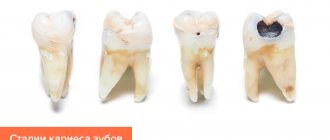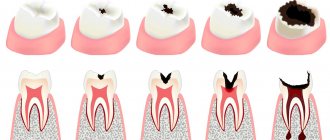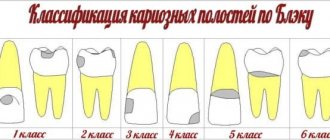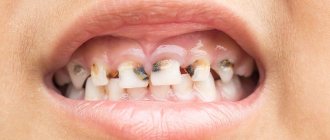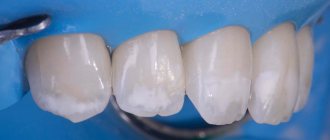Stages of caries development
The caries process develops sequentially in several stages:
Initial stage or caries in the white spot stage
Caries of primary teeth often begins with the appearance of white spots on the enamel. Over time, they may increase in size and change color to brown.
Superficial caries
At this stage of dental caries, the damage to the enamel is minor, but the tooth already reacts with aching pain to warm and hot food.
Average caries
A child can feel a carious cavity at the site of enamel destruction with his tongue, and parents and a doctor can see it with the naked eye. Pain when food gets on the tooth, as well as when eating hot and cold foods and drinks, increases.
Deep caries
The last stage, when not only the enamel is affected, but also the dental tissue. In the absence of treatment, inflammation of the pulp develops - pulpitis.
What types of caries are there?
fissure
caries - damage to the enamel affects special depressions on the chewing surface of the tooth - fissures.
Cervical
caries occurs in the area between the gum and the neck of the tooth, forming a kind of yellow or brown rim on the enamel.
Tooth root caries in children develops quite quickly in the absence of timely treatment of the initial forms of the disease.
Interdental
caries occurs between the lateral surfaces of adjacent teeth.
WHO (World Health Organization) offers the following classification of caries:
- enamel caries - superficial caries
- Dentin caries - spread of the inflammatory process under the enamel
- cement caries - damage to the root region of the tooth
In children, a separate classification is used - “according to Vinogradova”, on the basis of which the activity of the carious process is determined.
There is another children's classification that determines the activity of dental caries according to T.F. Vinogradova.
Based on an analysis of the number of carious teeth, the degree of their damage and the speed of development of the pathological process, Vinogradova identified three degrees of caries activity.
Compensated
This form of caries occurs in approximately half of children. The pathological process develops slowly; upon examination, isolated lesions of the teeth are detected. The enamel has a healthy shine. It is recommended for such children to visit the dentist once a year.
Subcompensated
The enamel is still shiny, but has some dull areas. As a rule, caries spreads horizontally; deep damage to the teeth is not observed.
The subcompensated form does not cause discomfort or complaints in children, but requires observation by a dentist with examinations at least once every 6 months.
Decompensated
The rarest and most severe form of caries with a high rate of development and serious complications in the form of pulpitis and periodontitis. The enamel is matte and rough, and the fissures are brown. Most often, when opening such a tooth, a carious cavity is discovered.
In case of decompensated form, the child is recommended to undergo preventive examinations at the dentist every 4 months.
Types of disease
Acute caries has two forms:
- medium spicy;
- deep spicy.
The difference between medium and deep acute forms lies in the size of the carious cavity. With moderate acute caries, there is no need to remove the nerve, and the tooth can be treated and restored. In case of deep acute caries, depulpation is usually required, and in case of severe tooth decay it is necessary to remove it.
Since in the acute form of the pathology the destruction of tooth tissue occurs very quickly, and children are most susceptible to the disease, in pediatric dentistry the following grouping is accepted:
- Compensated form (I group);
- Subcompensated (group II);
- Decompensated (group III).
Groups have been created to carry out clinical observation.
Pediatric dentist T. F. Vinogradova identified several dispensary groups:
- practically healthy teeth;
- compensated form;
- subcompensated form;
- decompensated form.
Children with a compensated form are examined once a year, with an undercompensated form - 2 times, with a decompensated form - 3 times. Planned sanitation reduces the risk of complications in the development of caries, the number of fillings and extracted teeth decreases. The need for treatment is also reduced by almost half, and the number of annual scheduled examinations is reduced.
Monitoring risk groups allows you to keep records based on a number of criteria:
- general prevalence of caries;
- anamnesis of life;
- health status;
- severity of the disease.
Planned sanitation and timely diagnosis of caries in adults and children make it possible not only to cure it in the initial stages, but also to prevent the development of blooming caries.
Manifestations of caries in children
The appearance of light or dark spots on tooth enamel
The first sign of caries in children is white spots on the enamel, resulting from calcium loss. At this stage, treatment may be minimal; often the doctor prefers minimally invasive methods, for example the ICON technique. The dentist applies a special preparation to the affected tooth tissue, thereby blocking the proliferation of bacteria and the development of the infectious process - caries is “preserved.”
If the white areas darken, dentin, the deep tissue of the tooth, is involved in the pathological process.
Cavity formation
In a child, the caries process develops very quickly, and the next stage is the formation of cavities. Most often they are visible upon examination even with the naked eye, and the child complains of pain while eating.
Reaction to food temperature
With the further development of the carious process, the affected tooth begins to react to hot, cold and sweet foods and drinks.
Pain
Pain occurs while eating - when food gets on a carious tooth. If the infectious process has spread to the pulp, the child will complain of pain constantly. Often unpleasant sensations occur during night sleep.
5.Bad breath
Food particles accumulate in carious cavities, bacteria cause rotting, so parents often complain about bad breath.
Superficial caries
If treatment is not carried out, the process progresses - the spot becomes soft and a small cavity forms under it - superficial caries. With superficial caries, pain occurs from chemical agents - sweet, salty or sour. Often this stage is asymptomatic, which makes it impossible to identify the process in the early stages. If the tooth is not treated in time, the carious cavity will increase and reach the dentin - medium caries or deep caries.
Forms of caries
There are 3 forms of caries according to the degree of intensity of development.
Compensated caries
It is characterized by sluggish, slow development without exacerbations. Enamel lesions are not pronounced, and there are no symptoms. Preventive measures and careful hygiene will help here.
Subcompensated caries
For several months, the carious lesion does not give any noticeable signals. The disease does not cause concern, but slight discomfort may occur while eating.
Decompensated
It is characterized by aggressive, rapid development. Accompanied by acute pain and requires immediate treatment. Before you know it, it spreads to neighboring teeth, causing multiple (generalized) caries.
Causes of decompensated caries
The decompensated form of caries starts when nothing prevents the proliferation of pathogenic microbes in the mouth.
The main causes of the disease are a decrease in the bactericidal properties of saliva (or decreased salivation), as well as errors in oral hygiene.
Other provoking factors include deficiency of vitamins and minerals, metabolic disorders, and bad habits.
Patients at risk
- children during milk bite;
- patients after prolonged infectious diseases;
- patients suffering from chronic pathologies (gastritis, diabetes, etc.) and mineral metabolism disorders;
- elderly people with weak immune systems.
The lower the patient’s immunity and body resistance, the faster the teeth deteriorate.
According to Black
This classification is one of the oldest and most reliable, allowing the dentist to determine the degree of neglect of the carious process and select the correct treatment. Classification of caries according to Black involves the identification of 6 classes, which combine symptoms and neglect of the destructive process of dentin. Each of them has its own characteristics:
- Class 1 - carious lesions are localized in the fissures (dimples and anatomical depressions of the chewing teeth) and on the inner sides of the canines and incisors.
- Class 2 – caries damage to the chewing surface of teeth that are located in the same row. Typically, class 2 caries occurs in people with a sweet tooth who cannot live a day without chocolate.
- Class 3 – caries is located between the contacting surfaces of the teeth (incisors or canines). The reason is poor oral hygiene and crooked teeth.
- Class 4 – damage to the contact surface of the incisors and canines, when carious spots destroy the corners of the tooth.
- Class 5 – caries in the cervical area of the tooth. Damage to dentin begins from the gums. The reason is poor hygiene and chronic gum diseases of an infectious and inflammatory nature.
- Class 6 – damage to the crowns of incisors and canines. This is often preceded by a malocclusion, which leads to mechanical abrasion of the enamel.
Each class has its own treatment protocol. But despite all the convenience and systematization, there are advantages and disadvantages of the Black classification, which makes it not so popular in modern dental practice. The main advantage of the system is the ability to determine the fundamental approach to treatment. Disadvantages:
- the individual characteristics of a particular carious cavity are not taken into account;
- There is no list of symptoms for advanced forms of the carious process.
But the Black classification is the basis that has helped and contributed to the improvement of dentistry in our time.
Classification according to the degree of tooth damage
- Enamel caries
This species is often called the “spot stage.” Some areas of tooth enamel become thinner due to a lack of minerals. A dark or white spot appears at this place.
- Dentin caries
It is also called internal, since microorganisms penetrate deep into the main tissue of the tooth - dentin. This type of caries is diagnosed in most people.
- Cementum (root) caries
The carious cavity is located directly below the gum level. It often affects the cervical part of the tooth. Root caries progresses rapidly and almost immediately leads to pulpitis. The reason is the formation of a periodontal pocket and exposure of the neck of the tooth. Most often, cement caries occurs in older people. Unfortunately, in most cases the disease is discovered when severe pain occurs.
- Odontoplasia
This is a pathology of the root system that is observed in most young children. Caries in primary teeth must be treated immediately. If this is not done, the carious process will affect permanent teeth. In addition, the enamel and dentin layers of children's teeth are very thin, and the carious process reaches the pulp in a matter of months.
- Suspended caries
If you take care of your health and the body’s defenses are high enough, then caries can seem to “freeze” at a certain stage, and the tooth does not further decay. However, this does not mean that you can postpone your visit to the doctor.



